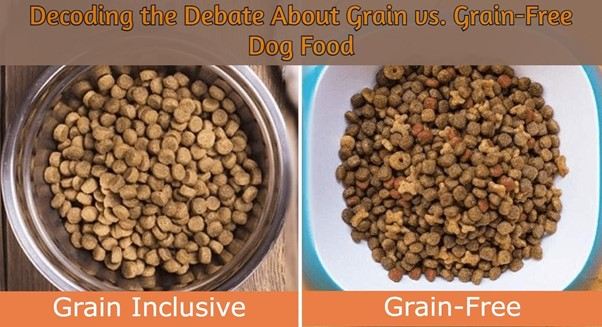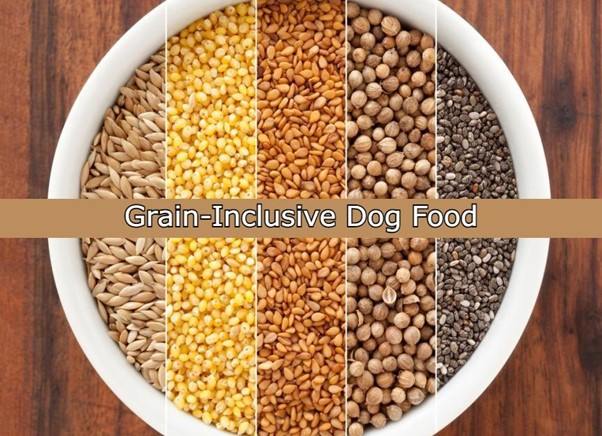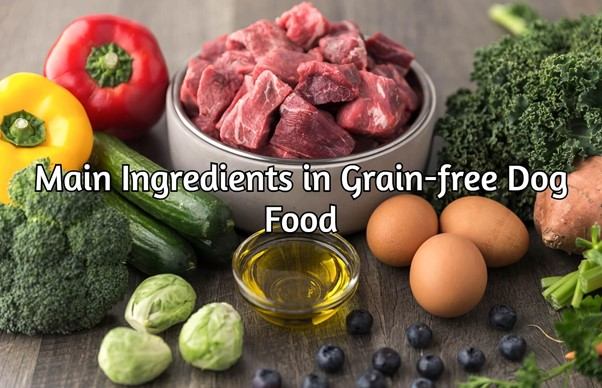Decoding the Debate About Grain vs. Grain- Free Dog Food
- Last updated on February 1, 2023
- By: Caroline Stowe
Taking care of a pup is no easy feat. From toys to vet visits, you have a lot to consider when it comes to your pup’s health and wellness.
One of the most important decisions you’ll have to make is what type of food to feed your pup. Deciding what to feed your pup can be tricky.
There are so many dog food options out there, from grain-filled to grain-free, that it can be hard to know which one is best for your pup.
So how can you decide which is best for your pup? Let’s dive into the debate around grain versus grain-free dog foods to help you make an informed decision about what’s best for your furry friend.
What is Grain Dog Food ?

Grain dog food has been around for much longer than its grain-free counterpart—and there’s a reason why it’s still popular today!
This type of kibble usually contains carbohydrates from grains such as corn or wheat as well as other ingredients like meat proteins and vegetables/fruits.
Despite their bad reputation, these grains can provide benefits as they contain essential vitamins and minerals that pups need such as Vitamins E, and B Vitamins, magnesium, zinc, and iron, among others.
The carbs provided by these grains are essential sources of energy for active pups (or those simply needing a little extra TLC!). Plus, grain-based diets tend to be easier on the wallet than their grain-free counterparts.
Not all grains are created equal though; some may contain allergens or preservatives that could cause health issues in certain breeds or individual dogs.
Main Ingredients in Grain-based Dog Food
The main and most common ingredients that are found in a grain-based dog food brand include:
- Grains (e.g. corn, wheat, barley, oats, rice, soy, rye )
- Meat proteins
- Vegetables/fruits
- Vitamin E
- B Vitamins
- Magnesium
- Zinc
- Iron
- Allergens or preservatives
- Carbohydrates
- Other nutrients like amino acids

Pros of Grain Dog Food
Grain Dog Food is a type of dog food that contains carbohydrates which are essential sources of energy for active pups. It comes from grains such as corn, wheat, barley, oats, and rice.
These grains are used as fillers in dog food and provide the necessary energy that a pup needs to keep up with its active lifestyle.
It also provides essential vitamins, minerals, B vitamins, and essential fatty acids that are crucial for a balanced diet.
The biggest pro associated with this type of dog food is that it tends to be cheaper than its grain-free cousin while still providing important nutrients needed by your pup.
Being more affordable, it is a good option for pet owners who are on a budget but still want to provide their pup with the nutrition they need.
Cons of Grain Dog Food
Grains can sometimes cause allergic reactions in certain dogs so if you know your pup has sensitivities then a different option might be better suited for them.
Additionally, some people might prefer not to feed their pup anything containing grains based on personal preferences even though research doesn’t indicate any significant health benefits from doing so either way.
What is Grain-Free Dog Food ?
Grain-free dog food is exactly what it sounds like—dog food without grains.
Grain-free dog foods don’t contain any grains at all—but they do still contain carbohydrates and proteins. Instead of using grain as the primary source of these ingredients, they use other plant sources like potatoes or legumes such as peas and lentils.
It typically contains animal proteins like chicken, beef, or fish as its main ingredients, along with vegetables and fruits for additional nutrients.
It also tends to be higher in fat content which could potentially lead to weight gain if not monitored carefully.
There are also often additional supplements like vitamins and minerals included in the mix. This type of diet may be appealing because it seems more “natural,” but there are still some potential drawbacks to consider before you commit.
These foods are usually higher in fat than their grain-filled counterparts but generally have fewer calories per serving than the grain variety.
They also tend to be more expensive because they don’t use cheaper filler ingredients like grains or corn syrup solids.
Main Ingredients in Grain-free Dog Food
The main and most common ingredients that are found in a grain-free dog food brand include:
- Animal proteins like chicken, beef, or fish
- Potatoes
- Legumes such as peas and lentils
- Vegetables and fruits
- Fish oil
- Eggs
- Fats and oils (such as flaxseed)
- Nuts and seeds (like pumpkin or sunflower seeds)
- Herbs, spices, and supplements like probiotics or glucosamine for joint health
- Vitamins and minerals (supplements)

What Are The Benefits Of Grain-Free Dog Food?
In recent years, grain-free diets have become increasingly popular among pet owners because they are believed to reduce allergens associated with grain-based foods.
It’s important to note that an allergy test by your vet should still be done if you think your dog has an allergy.
The biggest pro associated with grain-free dog food is that it usually contains high levels of protein, which can provide your pup with the essential nutrients they need to stay healthy.
Also, since there are no grains in the mix, it may be easier for dogs with allergies or sensitivities to digest this type of food than traditional grain-based diets.
Additionally, some pet parents prefer diets without grains because they believe these formulas may be closer to what their dogs would eat in the wild or contain fewer processed ingredients overall.
It’s also worth noting that many grain-free diets also contain higher levels of protein from alternative sources like peas or potatoes which could benefit active dogs who require more energy than other pups.
Cons of Grain-Free Dog Food
On the flip side, grain-free dog foods tend to be pricier than their grain counterparts and may not contain as many carbohydrates or fiber as needed for some dogs (especially active breeds).
Plus, some studies have linked certain types of grain-free diets to an increased risk for heart disease in dogs.
Which Is Better For My Dog – Grain Or Grain Free?
At the end of the day, each individual pup is different and it’s important to consult with your veterinarian about which option is best for your pup.
Ultimately, it really depends on your pup’s activity level and health needs as well as any allergies they may have. No matter which option you choose make sure to read ingredient lists carefully so that you know exactly what goes into your pup’s bowl!
The Truth About Linking Canine Heart Disease With Grain-Free Dog Food

With the recent news about the dangers of grain-free dog food, many pet owners are understandably concerned about their pup’s health. The truth is that linking Canine Heart Disease (CHD) to grain-free diets is more myth than fact, and research demonstrates this to be true.
In a 2019 study, only 13% of dogs with CHD were reported to have been fed a grain-free diet before the diagnosis. Researchers also found no link between grain inclusion and heart disease across 44 pet food brands included in the survey.
With that said, experts agree that it’s still important to monitor your furry friend’s nutritional needs and work with your veterinarian to find the best type of diet, as nutrition plays an important role in keeping your dog healthy.
Don’t let rumors get you down, this shouldn’t keep canine companions from enjoying the best life possible!
Conclusion
With so many options available on the market today it can be difficult to choose what type of dog food is best for your pup.
No matter which type of food you choose—grainy or grainless—it’s important to educate yourself before deciding what’s best for your pup’s dietary needs since each breed has its own unique set of nutritional requirements.
Researching different brands thoroughly and weighing out the pros and cons of each option will help you determine which one provides optimal nutrition while avoiding potentially harmful ingredients like preservatives and allergens; reading up on reviews from fellow pet owners might also come in handy!
Ultimately, finding what works best for your pup doesn’t have to be complicated; just remember that both types of food can provide essential nutrients while still giving them plenty of energy throughout their day!
All things considered, when it comes down to finding the right balance between nutrition and taste for your pup’s specific needs—grain vs grain-free—the choice is yours!
Good luck!
Check out what pet nutritionists think about grain-inclusive and grain-free dog food.
-
Author: Caroline Stowe
- Updated on February 1, 2023
Disclaimer: This article doesn’t intend to replace professional veterinary advice, nor should it be used as a substitute for veterinary services, diagnosis, or treatment. The content on this website, including information and opinions expressed herein, are intended for general informational purposes only. In case you have concerns or questions regarding your dog’s health and diet requirements, please consult your veterinarian before doing anything that might affect it.
DogPetGuide.com and the writer are not responsible or liable for any damage, liability, costs, or claims arising from any possible consequences of the reader’s action after reading this article.




